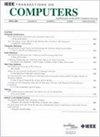RelHDx:利用场效应晶体管加速图上学习的超维计算
IF 3.6
2区 计算机科学
Q2 COMPUTER SCIENCE, HARDWARE & ARCHITECTURE
引用次数: 0
摘要
图神经网络(gnn)是一种强大的机器学习(ML)方法,用于分析图数据。GNN的训练具有计算和内存密集型阶段以及不规则的数据移动,这使得内存加速具有挑战性。我们提出了一个基于超维计算(HDC)的图形机器学习框架,称为RelHDx,它聚合节点特征和图结构,以及在高维空间中表示节点和边缘信息。RelHDx可以通过简单的算术运算进行单次训练和推理,从而有效地设计基于图的ML任务:节点分类和链接预测。我们使用基于新兴铁电场效应管(FeFET)技术的可扩展内存处理(PIM)架构来加速RelHDx。我们的加速器使用数据分配优化和操作调度器来解决图形的不规则性并最大化性能。评估结果表明,RelHDx提供了与流行的基于gnn的算法相当的精度,同时在GPU上实现了高达63.8\boldsymbol{\times}$的速度。我们基于fefet的加速器RelHDx-PIM在节点分类方面的速度要快32美元,而在链路预测方面,它比在GPU上运行时快65.4美元。此外,RelHDx-PIM的能效比GPU提高了4个数量级。与最先进的基于内存处理的GNN加速器PIM-GCN[1]相比,RelHDx-PIM平均速度快10美元,能效高986美元。本文章由计算机程序翻译,如有差异,请以英文原文为准。
RelHDx: Hyperdimensional Computing for Learning on Graphs With FeFET Acceleration
Graph neural networks (GNNs) are a powerful machine learning (ML) method to analyze graph data. The training of GNN has compute and memory-intensive phases along with irregular data movements, which makes in-memory acceleration challenging. We present a hyperdimensional computing (HDC)-based graph ML framework called RelHDx that aggregates node features and graph structure, along with representing node and edge information in high-dimensional space. RelHDx enables single-pass training and inference with simple arithmetic operations, resulting in the efficient design of graph-based ML tasks: node classification and link prediction. We accelerate RelHDx using scalable processing in-memory (PIM) architecture based on emerging ferroelectric FET (FeFET) technology. Our accelerator uses a data allocation optimization and operation scheduler to address the irregularity of the graph and maximize the performance. Evaluation results show that RelHDx offers comparable accuracy to popular GNN-based algorithms while achieving up to $63.8\boldsymbol{\times}$ $32\boldsymbol{\times}$ $65.4\boldsymbol{\times}$ [1] , RelHDx-PIM is $10\boldsymbol{\times}$ $986\boldsymbol{\times}$
求助全文
通过发布文献求助,成功后即可免费获取论文全文。
去求助
来源期刊

IEEE Transactions on Computers
工程技术-工程:电子与电气
CiteScore
6.60
自引率
5.40%
发文量
199
审稿时长
6.0 months
期刊介绍:
The IEEE Transactions on Computers is a monthly publication with a wide distribution to researchers, developers, technical managers, and educators in the computer field. It publishes papers on research in areas of current interest to the readers. These areas include, but are not limited to, the following: a) computer organizations and architectures; b) operating systems, software systems, and communication protocols; c) real-time systems and embedded systems; d) digital devices, computer components, and interconnection networks; e) specification, design, prototyping, and testing methods and tools; f) performance, fault tolerance, reliability, security, and testability; g) case studies and experimental and theoretical evaluations; and h) new and important applications and trends.
 求助内容:
求助内容: 应助结果提醒方式:
应助结果提醒方式:


